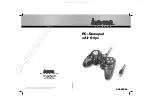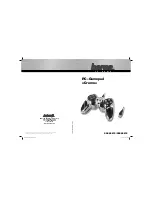
Other Checks
Analog Space Temperature Sensor
If the Space Temperature Sensor is not reading a valid tempera-
ture, make sure the wiring terminal connections are tight and
that any wiring splices are properly connected. You can check
the operation of the Space Temperature Sensor by measuring the
resistance or voltage using a digital multimeter. Set the meter
to DC Volts. Place the positive probe on the AIN terminal and
the negative probe on the GND terminal. Read the DC Volts
and fi nd that voltage in
Table 5, page 42
. Read the temperature
corresponding with that voltage and determine if this is close to
the actual temperature the sensor is exposed to. If the tempera-
ture from the chart is diff erent by more than a few degrees, you
probably have a defective or damaged sensor. You can also check
the sensor resistance to determine correct operation. To read the
resistance, set the meter to Ohms. Unplug the sensor connector
from the board and measure the resistance across the discon-
nected wires. This resistance should match the corresponding
temperature from
Table 5, page 42
.
E-BUS Digital Room Temperature Sensor
If the E-BUS Digital Room Temperature Sensor is not displaying
a valid temperature, fi rst make sure that the E-BUS modular cable
connector is fi rmly plugged into the E-BUS modular connector on
the board and at the Temperature Sensor. If the problem persists,
try swapping the sensor with a known good Room Temperature
Sensor. If that sensor works when connected to the VAV/Zone
Controller, you can assume you have a defective or damaged sen-
sor. If you are using a terminal connector to connect the sensor,
follow the instructions for the Analog Space Temperature Sensor .
Supply Air Temperature Sensor
If you suspect the Supply Air Temperature Sensor is not reading
correctly, make sure the wiring terminal connections are tight
and that any wiring splices are properly connected. You can
check the operation of the Supply Air Temperature Sensor by
measuring the resistance or voltage using a digital multimeter.
Set the meter to DC Volts. Place the positive probe on the AIN
terminal and the negative probe on the GND terminal. Read the
DC Volts and fi nd that voltage in
Table 5, page 42
. Read the
temperature corresponding with that voltage and determine if
this is close to the actual temperature the sensor is exposed to.
If the temperature from the chart is diff erent by more than a few
degrees, you probably have a defective or damaged sensor. You
can also check the sensor resistance to determine correct opera-
tion. To read the resistance, set the meter to Ohms. Unplug the
sensor connector from the board and measure the resistance
across the disconnected wires. This resistance should match the
corresponding temperature from
Table 5, page 42
.
Airflow Sensor
If the Airfl ow Sensor seems to be reading incorrectly, check the
Airfl ow Sensor tubing connections at the airfl ow pickup tubes.
The high pressure port of the sensor needs to be connected to the
upstream pickup tube. The low pressure port of the sensor needs
to be connected to the downstream pickup tube.
The “Air Valve Sizing Constant” setting under the confi guration
settings for the VAV/Zone Controller must be set to a number
other than 0. This number is normally referred to as the “K” factor
and is supplied by the terminal unit manufacturer. It represents
the airfl ow through the box inlet at 1” W.G. constant static pres-
sure. This factor must be entered in the confi guration screen or
the airfl ow through the box will be incorrect.
If none of the procedures above solves the problem, remove
power from the VAV/Zone Controller. Shut down the HVAC unit
supplying the duct that the VAV/Zone damper is located on. Be
sure that no airfl ow is present in the duct. Reapply power to the
board and wait for the VAV/Zone Controller to run through its
calibration sequence. Restart the HVAC unit and check the VAV/
Zone Controller CFM readings. If the CFM reading still seems
to be in error, you probably have a defective Airfl ow Sensor and
will need to replace it.
Diagnostics
39
VAV/Zone Controller Package
TROUBLESHOOTING














































